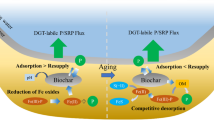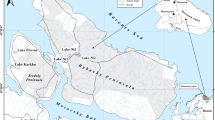Abstract
Annual variations in concentrations of Fe forms in the bottom water (0–70 cm from the bottom, by layers), pore water, and in solid phase of silts (25 cm, by layers) of the Krasnovidovo Pool channel area of the Mozhaisk Reservoir are studied. A drastic increase in the concentration and ratio of Fesusp/Fedis in the water layer 0–20 cm from the bottom is detected. Fe(II) dominates in dissolved and suspended forms. The concentrations of Fe(III) reaching 2–3 mg/l were for the fist time revealed in the pore water of silts (Eh ∼ −120 mV). The factors responsible for this phenomenon are discussed. Fe flux from sediments is tentatively assessed as 0.2–0.6 mg Fe m2/day.
Similar content being viewed by others
References
Arinushkina, E.V., Rukovodstvo po khimicheskomu analizu pochv (Guide on Soil Chemical Analysis), Moscow: Mosk. Gos. Univ., 1961.
Asatiani, V.S., Biokhimicheskii analiz (Biochemical Analysis), Tbilisi: Tsodna, 1962, vol. 1.
Vinogradova, N.N., Suspended Matter and Bottom Sediments, in Kompleksnye issledovaniya vodokhranilishch (Multidisciplinary Studies of Reservoirs), Moscow: Mosk. Gos. Univ., 1979, issue III, pp. 231–261.
Vodyanitskii, Yu.N., Khimiya i mineralogiya pochvennogo zheleza (Chemistry and Mineralogy of Soil Iron), Moscow: Pochv. Inst. RASKhN, 2003.
Garrels, R. and Christ, Ch., Solutions, Minerals, and Equilibria, New York: Harper and Row, 1965.
Ershova, M.G., Water Masses, in Kompleksnye issledovaniya vodokhranilishch (Multidisciplinary Studies of Reservoirs), Moscow: Mosk. Gos. Univ., 1979, issue III, pp. 165–192.
Zakhar’evskii, M.S., Express Method for the Determination of Oxidation-Reduction Potential of Bioloigical Systems, Mikrobiologiya, 1940, vol. 9, no. 9–10, pp. 50–55.
Kortsenshtein, V.N., Rastvorennye gazy podzemnoi gidrosfery Zemli (Dissolved Gases of the Subsurface Hydrosphere of the Earth), Moscow: Nedra, 1984.
Krauskopf, K.B., Separation of Manganese and Iron in Sedimentation Process, in Geokhimiya litogeneza (Geochemistry of Lithogenesis), Moscow: Inostrannaya Literatura, 1963, pp. 259–293.
Kuznetsov, S.I. and Romanenko, V.I., Oxidation-Reduction Potential in Surface Layers of Silt Deposits in Different Types of Lakes, Dokl. Akad. Nauk SSSR, 1963, vol. 151, no. 3, pp. 351–355.
Linnik, P.N., and Nabivanets, B.I., Formy Migratsii Metallov v Presnykh Poverkhnostnykh Vodakh (Forms of Migration of Metals in Fresh Surface Waters), Leningrad: Gidrometeoizdat, 1986.
Martynova, M.V., Samplers for Studying Near-Bed Water, in Voprosy gidrologicheskogo priborostroeniya (Issues of Hydrological Equipment), Leningrad: Gidrometeoizdat, 1977, pp. 75–77.
Martynova, M.V., The Role of Bottom Sediments in Nitrogen and Phosphorus Turnover in the Mozhaisk Reservoir, in Protsessy formirovaniya kachestva vody v prit’evykh vodokhranilishchakh (Processes of Water Quality Formation in Drinkin-Water Reservoirs), Moscow: Mosk. Gos. Univ., 1979, pp. 49–66.
Martynova, M.V., Spatial and Temporal Distributions of Phosphorus Compounds in the Bottom Water of a Small Reservoir, Vodn. Resur., 2004, vol. 31, no. 3, pp. 318–324 [Water Resour. (Engl. Transl.), vol. 31, no. 3, pp. 290–296].
Martynova, M.V., On the Effect of Watershed Size on the Internal Phosphorus Load, Geogr. Prir. Res., 2005, no. 3, pp. 24–28.
Martynova, M.V. and Shmideberg, N.A., On Methods for the Determination of Different Phosphorus Forms in Bottom Sediments, Gidrokhim. Mater., 1983, vol. 85, pp. 49–55.
Martynova, M.V. and Shmideberg, N.A., On the Chemical Composition of Silts in the Mozhaisk Reservoir, in Kompleksnye issledovaniya vodokhranilishch (Multidisciplinary Studies of Reservoirs), Moscow: Mosk. Gos. Univ., 1980, issue V, pp. 125–134.
Romanenko, V.I., Mikrobiologicheskie protsessy produktsii i destruktsii organicheskogo veshchestva vo vnutrennikh vodoemakh (Microbiological Processes of Production and Destruction of Organic Matter in Inland Water Bodies), Leningrad: Nauka, Leningr. Otd., 1985.
Romanenko, V.I. and Kuznetsov, S.I., Ekologiya mikroorganizmov presnykh vod: Laboratornoe rukovodstvo (Ecology of Freshwater Microorganisms: Laboratory Guide), Leningrad: Nauka, 1974.
Sapozhnikov, V.V. and Nosova, V.V., Methods and Some Preliminary Results of the Determination of Various Phosphorus Forms in the Mozhaisk Reservoir Water, in Gidrokhimicheskie issledovaniya poverkhnostnykh i podzemnykh vod raiona Mozhaiskogo vodokhranilishcha (Hydrochemical Studies of Surface and Subsurface Waters of Mozhaisk Reservoir Area), Moscow: Mosk. Gos. Univ., 1977, pp. 23–34.
Strakhov, N.M., Tipy litogeneza i ikh evolyutsiya v istorii Zemli (Types of Lithogenesis and Their Evolution in the Earth History), Moscow: Gosgeotekhizdat, 1963.
Alperin, M.E., Martens, Ch.S., Albert, D.B., et al., Benthic Fluxes and Pore Water Concentration Profiles of Dissolved Organic Carbon in Sediments from North California Continental Slope, Geochim. Cosmochim. Acta, 1999, vol. 63, nos. 3/4, pp. 427–448.
Andersson, A., Relative Efficienty of Nine Different Soil Extractants, Swedish L. Agric. Res., 1975, no. 5, pp. 125–135.
Buffalar, S.E. and Allen, H.E., Sediment Pore Water Collection Methods for Trace Metal Analysis: a Review, Water Res., 1995, vol. 29, no. 1, pp. 165–187.
Carey, E. and Taillefert, M., The Role of Soluble Fe(III) in the Cycling of Iron and Sulfur in Coastal Marine Sediments, Limnol. Oceanogr., 2005, vol. 50, no. 4, pp. 1129–1141.
Einsele, W., Versuch Eiene Theorie Der Dynamic Der Mangan-and Eisenschichtung Im Eutrophen Seen, Naturwissenschaften, 1940, vol. 28, pp. 280–285.
Elrod, V.A., Berelson, W.M.., Coale, K.H., and Johnson, K.H., The Flux of Iron from Continental Shelf Sediments: a Missing Source for Global Budgets, Geophys. Res. Lett., 2004, vol. 31, no. 12, pp. L12307/1–L12307/4.
Golterman, H.L. and Clumo, R.S., Methods for Chemical Analysis of Fresh Water, Oxford: Blackwell Scientific Publications, 1969.
Johnson, K.S., Chavez, F.P., and Friederich, G.E., Continental Shelf Sediment as Primary Source of Iron for Coastal Phytoplankton, Nature, 1999, vol. 358, no. 6483, pp. 697–700.
Kostka, J.E., Dalton, D.D., Skelton, H., et al., Growth of Iron-Reducing Bacteria on Clay Minerals as the Sole Electron Acceptor and Comparison of Growth Yields on a Variety of Oxidized Iron Forms, Appl. Environ. Microbiol., 2002, vol. 68, no. 12, pp. 6256–6262.
Lovely, D.R. and Phillips, E.J.P., Availability of Ferric Iron for Microbial Reduction in Bottom Sediments of the Freshwater Tidal Potomac River, Appl. Environ. Microbiol., 1986, vol. 52, no. 4, pp.751–757.
Moalla, S.M.N., Awadallah, R.M., Rashed, M.N., and Soltan, M.E., Distribution and Chemical Fractionation of Some Heavy Metals in Bottom Sediments of Lake Nasser, Hydrobiol., 1998, vol. 364, pp. 31–40.
Postma, D., Concentration of Mn and Separation from Fe in Sediments. — 1. Kinetics and Stoicheometry of the Reaction between Birnessite and Dissolved Fe(II) at 10°C, Geochim. Cosmochim. Acta, 1985, vol. 49, no. 4, pp. 1023–1033.
Redshaw, C.J., Mason, C.F., Hayes, C.R., and Roberts, R.D., Factors, Influencing Phosphate Exchange across the Sediment-Water Interface of Eutrophic Reservoirs, Hydrobiol., 1990, vol. 192, nos. 2–3, pp. 233–245.
Stumm, W. and Morgan, J.J., Aquatic Chemistry, New York: Wiley, 1981.
Van Cappelin, P. and Wang, Y., Cycling of Iron and Manganese in Surface Sediments: A General Theory for the Coupled Transport and Reaction of Carbon, Oxygen, Nitrogen Sulfur, Iron and Manganese, Am. J. Sci., 1996, vol. 296, no. 3, pp. 197–243.
Author information
Authors and Affiliations
Additional information
Original Russian Text © M.V. Martynova, 2009, published in Vodnye Resursy, 2009, Vol. 36, No. 1, pp. 80–88.
Rights and permissions
About this article
Cite this article
Martynova, M.V. Peculiarities of annual variations in the concentration of iron compounds in the water-bottom sediments system of the Mozhaisk Reservoir. Water Resour 36, 76–85 (2009). https://doi.org/10.1134/S0097807809010072
Received:
Published:
Issue Date:
DOI: https://doi.org/10.1134/S0097807809010072




